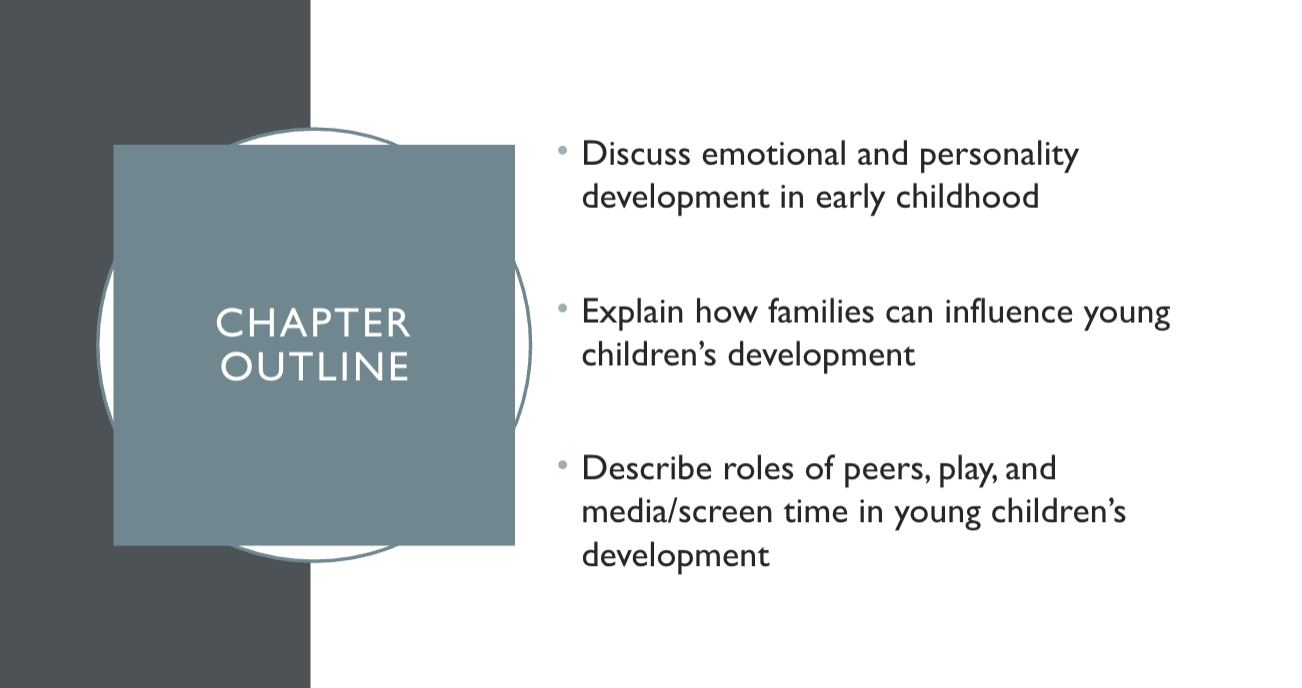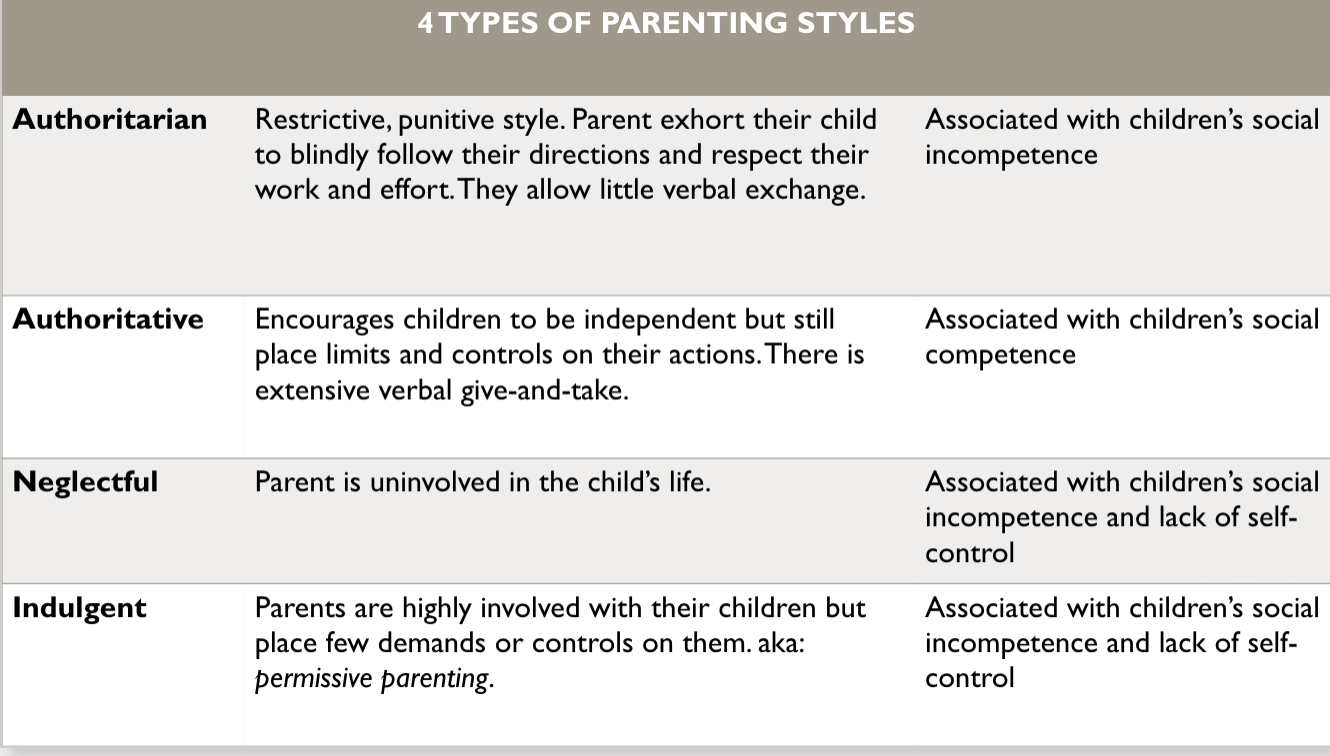Chapter 8
Socioemotional Development in Early Childhood

Emotional and Personality Development
Children’s developing minds and social experiences produce remarkable advances in the development of:
The self
Emotions
Morality
Gender
The Self
Erikson’s 3rd psychosocial stage of development is initiative vs guilt
Occurs in ages 3 to 5 years
Children use perceptual, motor, cognitive, and language skills more
At this stage, children tend to move out into a wider social world on their own
The great governor of “initiative” is conscience
Initiative and enthusiasm may bring guilt, which lowers self-esteem
Self-Understanding
There is an increase in awareness at this stage
Self-understanding is the representation of self, the substance and content of self-concepts
Early self-understanding involves self-recognition
Children describe the self by material characteristics: size, shape, and color
They distinguish themselves from others though physical and material attributes
“I am different from Jennifer because I have brown hair, and she has blonde hair”
“I am different from John, because I have a red bicycle”
Later Stages of Self-Understanding
At around 4-5 years of age, children will begin to use psychological trains and emotions in their own self-descriptions
“I am not scared. I am always happy”
Young children’s self-descriptions are typically unrealistically positive
This largely because they cannot distinguish their desired competence vs their actual competence
Confuse ability and effort
Do not engage in spontaneous social comparisons
They compare their present abilities with what they could not do at an earlier age
Overestimation of their attributes helps protect young children from negative self-evaluations
Understanding Others
Huge advancement can come from their understanding of others and children’s capacity to learn from others
At around 4-5 years, they start perceiving others in terms of psychological traits
“My teacher is nice”
Children begin to understand that people make statements that aren’t true to obtain something they want or to avoid trouble
“If your aunt calls, tell her I’m in the shower”
“When we get to the gate, pretend you’re 3 so they don’t charge your ticket”
Emotional Development
Self-conscious emotions appear once self-awareness occurs
Pride, shame, embarrassment, and guilt
During early childhood, pride and guilt become more common
These will be especially influences by paren’t responses to children’s behaviors
A young child might experience shame when a parent says, “you should feel bad about not sharing with your sister”
Understanding and Regulating Emotions
One of the most important advances in emotional development in early childhood is an increased understanding in emotion
They become aware that:
Some situations are likely to evoke particular emotions
Facial expression indicate specific emotions
Emotions affect behavior
Emotions can be used to influence other’s emotions
Emotion regulation helps children manage the demands and conflicts involves in interacting with others
Families
Families are probably the biggest social influence on young children’s development
Parenting
Child maltreatment
Sibling relationships and birth order
The family dynamics in a changing society
Parenting
To understand variations in parenting and child outcomes, consider:
The styles parents use when interacting with their children
How they discipline their children
The dynamics of coparenting
The impact of COVID-19 on parenting and nurturing children

Sibling Relationships
Important characteristics of sibling relationships include:
Emotional quality of the relationship - positive, negative, or mixed feelings
Familiarity and intimacy of the relationship - knowing each other well can allow for mutual support or teasing and undermining each other
Variation in sibling relationships - some describe the relationship as more positive than others
Birth order
Whether a child has older or younger siblings has been linked to development of certain personality characteristics
Compared with later-born children, firstborn have been described as more adult-oriented, helpful, conforming, and self-controlled
This could be attributed to parentification and adultification
Peer Relations
Peer relations can provide a source of information and comparison to the child about the world outside their family unit
Good peer relations can be necessary for normal socioemotional development
Basic lifestyle decisions by parents can determine the pool from which their children select possible friends
At this stage, their peers may include neighborhood children at daycare facilities, and the children of the parent’s friends
Play
Observing a child playing can provide important context for their development of language and communication skills
Sensorimotor play - behavior by infants that lets them derive pleasure from exercising their sensorimotor schemes
Practice play - involves repetition of behavior when new skills are being learned
Pretense symbolic play - occurs when child transforms their physical environment into a symbol (e.g., a stick becomes a wand/sword).
Social play - involves interactions with peers
Constructive play - combines sensorimotor and practice play with symbolic representation
Media/Screen time
Screen time describes the amount of time individuals spend using electronic devices
Although television continues to have a strong influence on children’s development, children now use other types of media as well:
Television
Mobine media on smartphoens/tablets
Video games
Computers
Parenting in a changing society
The American society SUCKS BOOTY